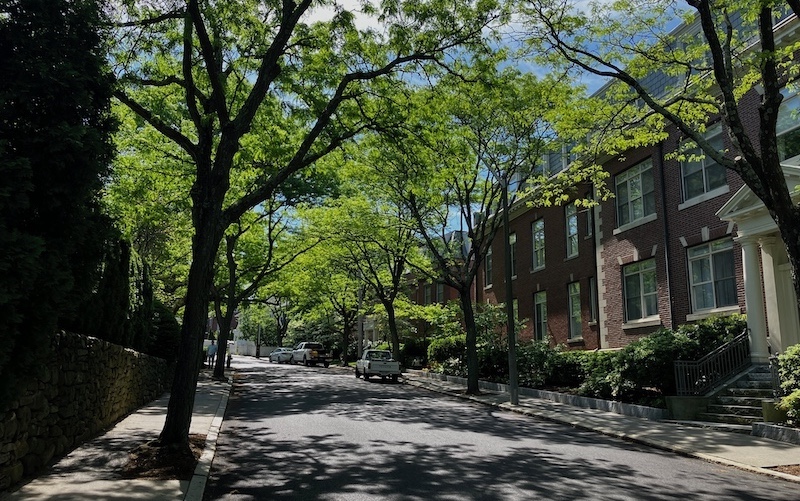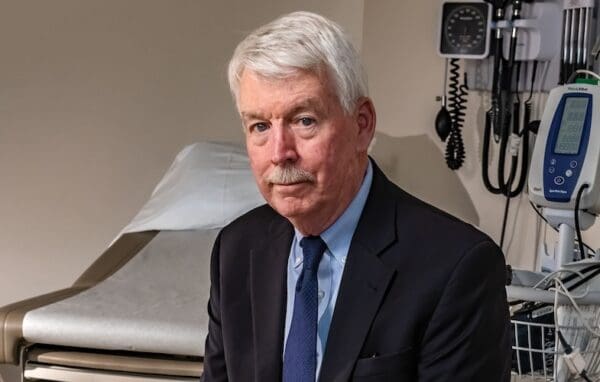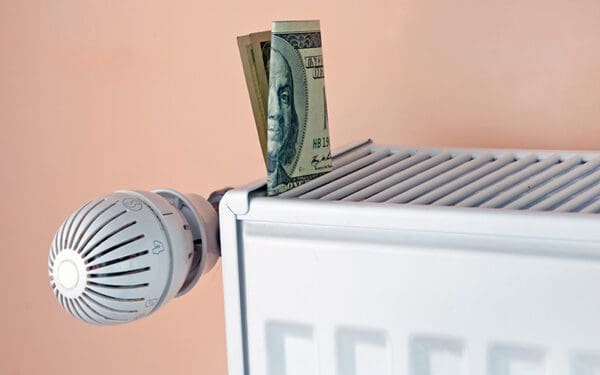
The number of trees in your neighborhood is a matter of environmental justice. Photo: Pam Reynolds
I live on the border of two very different worlds. One is leafy and green, with streets lined with mature trees, lush parks, and patches of luxuriant lawn. The other is the opposite: brick apartment buildings or multi-family houses on blocks largely devoid of trees.
Only a matter of feet separates these two divergent worlds. In one, a summer day may feel warm but still pleasant. Kids play on swings as parents watch indulgently from shady park benches. In the other, a summer day can quickly grow stifling. People stay indoors running fans or, if they can afford them, air conditioners in stuffy apartments.
I’m not surprised at these disparities. In U.S. towns and cities, vast inequalities in tree cover come with, well, the territory. According to American Forests, low-income neighborhoods have 41% fewer trees than wealthier ones. Communities of color have 33% fewer trees than predominantly white ones. I experience this dichotomy every time I step outside my home in Brighton, Massachusetts. And the fact is, this troubling imbalance holds broad social implications for our cities as we grapple with an overheated planet.


The Shade Gap is a Wealth Gap
Turning two blocks to the right in my neighborhood will land me in the verdant town of Brookline, where abundant Green Ash trees protect me under what is known as an “urban tree canopy.” This corner of town boasts a Tree Equity Score of a nearly perfect 99 out of 100, meaning that 38% of that neighborhood is covered in trees.
Researchers now know that this kind of tree canopy is essential to physical and mental health, as well as climate resilience. Trees and green spaces protect streets from flooding when they soak up heavy rains in extreme storms. They also shield against extreme heat, lowering the temperature on hot summer days by as much as 10 degrees. A cooler neighborhood prevents homes from heating up so quickly, so people can get away with using fewer fans and less air-conditioning.
One block to the left in Brighton, the scene looks very different. This area of Boston scores 82 on the Tree Equity scale, placing the tree canopy cover at 23 percent. And a few blocks further north, in Allston (which scored 70), the tree canopy declines precipitously to just 8 percent. That means that people living in these neighborhoods are at risk for a whole host of ills most people don’t immediately associate with a lack of trees.
Trees Reflect Residents’ Health
Studies show that kids growing up in areas with fewer street trees are more likely to develop asthma than kids surrounded by trees. Other studies show that trees reduce stress, lower traffic noise, reduce the frequency of car accidents, and encourage walking. Street trees may even help lower crime.
You can probably guess which neighborhood I choose for afternoon walks. You can also guess which neighborhood is whiter and wealthier. The median household income in Allston-Brighton is just a little more than half that of well-to-do Brookline. And Asians, Hispanics, and Blacks make up a greater percentage of the population of Allston-Brighton than Brookline.
The Tree Haves and Have-Nots
Research supports my own lived experience. In one study, the Nature Conservancy found that 92 percent of low-income blocks in the U.S. have less tree cover and hotter average temperatures than high-come blocks. The worst discrepancies were found in the Northeast, especially in Connecticut. The lowest-income city blocks in Bridgeport, Connecticut, had 54 percent less tree cover and were substantially hotter on sweltering days than wealthier ones.
Behind the numbers are stark realities as uncomfortable as the blazing summer sun on searing hot pavement. All the benefits of trees, including increased resilience from extreme weather and cleaner air, flow chiefly to the wealthy. If you make less money, the odds are that you’re breathing in dirtier air and more exposed to extreme weather’s effects.
Gaps in Tree Cover Aren’t by Chance
I ponder this discrepancy whenever I turn left at the end of my block. I also reflect on this: the number of trees in a neighborhood is not a matter of happenstance. Where we find trees today, reflect exclusionary zoning laws, racial segregation, and the country’s wealth inequality.
Private lenders practicing redlining based on race, religion, and immigrant status sent certain categories of people to certain places. And where people of color were allowed to buy homes or rent were often denser neighborhoods where public investments, like street trees, were not made.
These neighborhoods are also more likely to have a much higher percentage of rental properties. And renters need permission from landlords to plant trees. Even if a renter can get a landlord to take advantage of a “free tree” city program, renter turnover means that the tree’s odds of survival are low unless the city commits to watering it. In Allston-Brighton, about 80 percent of residents rent, and 30 percent are people of color. The neighborhood includes many recent immigrants from countries that include China, Brazil, and Russia. These immigrants live in multi-family dwellings and, far too often, on treeless streets.
Getting More Trees in More Neighborhoods
As the climate heats up, the benefits of trees have become more apparent, as has the inequality in where they are planted. While trees alone can’t reverse climate change, they can unquestionably help us cope with its effects while improving our quality of life in fundamental ways. That’s why the USDA awarded $1 billion last year to plant more trees and add more green spaces in cities, towns, and suburbs across the country.
In New England, cities and towns should be working in tandem to redouble efforts to spread this greenery around, especially to environmental justice communities where it is needed most urgently. That’s why CLF is working on initiatives like that in Manchester, New Hampshire, where we collaborated with The Nature Conservancy to get a $2.2 million grant to plant trees in environmental justice neighborhoods.
We’re also calling on towns and cities to do more strategic and studied work on urban forest planning. That includes taking a regular tree inventory to monitor tree health. It also means planning for curb bump-outs so that tree roots don’t obstruct pedestrian access on sidewalks. Cities must think ahead about making room for trees in spaces where cars, electric wires, or solar panels might seem to conflict. And they must plan not only for the cost of new trees, but the cost of stump removal and hiring additional staff to water and help young trees establish themselves.
It’s not a simple one-step process. But if we don’t get serious about addressing the blatant tree inequity around us, we’ll live in a world that none of us want: where the green in your neighborhood depends on the green in your wallet.
This is one of an occasional series that reveals the truth about environmental issues.



